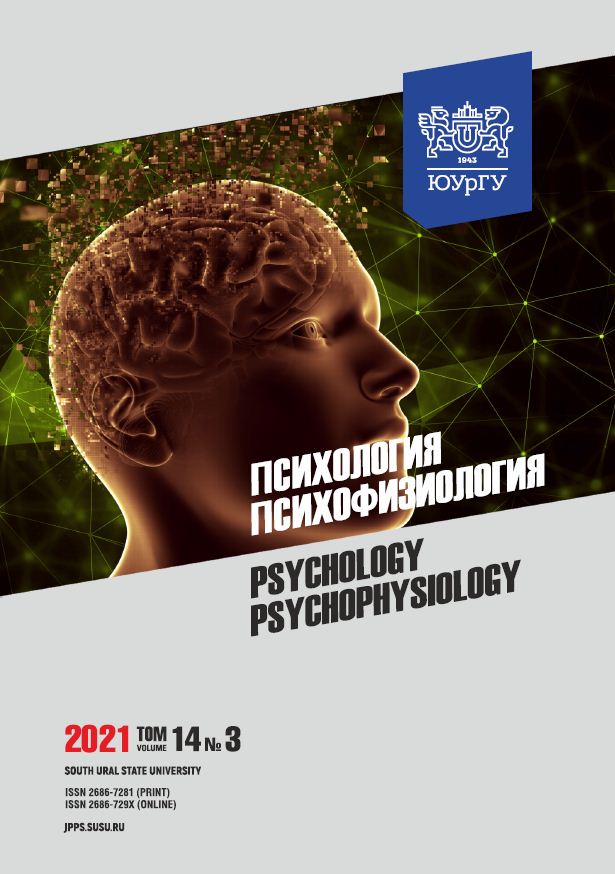FEATURES OF EMOTION RECOGNITION BY FACIAL EXPRESSION IN PATIENTS WITH EPILEPSY
Abstract
Abstract. The assessment of other person's emotions by facial expression is important for social interaction, especially in case of various cerebral disorders. Aim. The research is aimed at investigating the features of emotion recognition by facial expression in patients with epilepsy compared to apparently healthy persons. Materials and methods. The study involved one experimental (epilepsy patients) and one control group. A total of 44 persons participated in the study, including 33 women (75%) and 11 men (25%). The average age of the sample was 25 (4.6) years (M (σ)). The experimental group consisted of 17 participants, including 8 women (47%) and 9 men (53%) with the average age of 26.9 (5.7) years. The control group consisted of 27 participants,
including 25 women (92.5%) and 2 men (7.5%) with the average age of 23.7 (3.4) years.
The participants were recruited in the program between July 2020 and March 2021. Each participant used the computer program “Emotion Recognition” created on the basis of the “Dynamic Faces” database (Emotional Facial Expression, KDEF-dyn database). Two parameters were evaluated, namely the speed and accuracy of emotion recognition. The study hypothesizes that emotion recognition by mimic expression of the negative spectrum in epilepsy patients will differ from those of apparently healthy participants. Results. Impairments in the recognition of negative emotions (sadness, anger, and disgust) by mimic expression were found in patients with epilepsy. A decrease in the rate of disgust recognition was also found compared to apparently healthy participants. Conclusion. The data obtained can explain interpersonal problems that affect the quality of life in epilepsy patients and serve as a basis for the development of psychotherapeutic programs for improving interpersonal skills and social adaptation of epilepsy patients.
Downloads
References
2. Fisher R.S., Van Emde B.W., Blume W. et al. Epileptic seizures and epilepsy: definitions proposed by the International League Against Epilepsy (ILAE) and the International Bureau for Epilepsy (IBE). Epilepsia. 2005; 46: 470–472. DOI: 10.1111/j.0013-9580.2005.66104.x
3. Mirabel H., Guinet V., Voltzenlogel V. et al. Social cognition in epilepsy: State of the art and perspectives. Revue Neurologique. 2020; 176 (6): 468–479. DOI: 10.1016/j.neurol.2020.02.010.
4. Hennion S., Delbeuck X., Duhamel A. et al. Characterization and prediction of theory of mind disorders in temporal lobe epilepsy. Neuropsychology. 2015; 29 (3): 485–492. DOI: 10.1037/neu0000126
5. Elfenbein H.A., Ambady N. On the universality and cultural specificity of emotion recognition: a meta-analysis. Psychol Bull. 2002; 128: 203–235. DOI: 10.1037/0033-2909.128.2.203
6. Edwards M., Stewart E., Palermo R., Lah S. Facial emotion perception in patients with epilepsy: A systematic review with meta-analysis. Neurosci Biobehav. 2017; 83: 212–225. DOI: 10.1016/j.neubiorev.2017.10.013.
7. Atkinson A.P., Dittrich W.H., Gemmell A.J., Young A.W. Emotion perception from dynamic and static body expressions in point-light and full-light displays. Perception. 2004; 33(6): 717–746. DOI: 10.1068/p5096
8. Allison T., Puce A., McCarthy G. Social perception from visual cues: role of the STS region. Trends in Cognitive Sciences. 2000; 4: 267–278. DOI: 10.1016/s1364-6613(00)01501-1
9. Koh M.Y., Lim K.S., Fong S.L. et al. Impact of COVID-19 on quality of life in people with epilepsy, and a multinational comparison of clinical and psychological impacts. Epilepsy Behav. 2021; 117: 107849. DOI: 10.1016/j.yebeh.2021.107849.
10. Monti G., Meletti S. Emotion recognition in temporal lobe epilepsy: A systematic review. Neuroscience & Biobehavioral Reviews. 2015; 55: 280–293. DOI: 10.1016/j.neubiorev.2015.05.009.
11. Wu L., Yang X., Zhang K. et al. Impairment of eye emotion discrimination in benign childhood epilepsy with centrotemporal spikes: A neuropsychological study. Brain Behav. 2021; 11 (6): e02154. DOI: 10.1002/brb3.2154
12. Karanja S.W., Kiburi S.K., Kangethe R., Othieno C.J. Emotional and behavioral problems in children with epilepsy attending the pediatric neurology clinic at a referral hospital in Kenya. Epilepsy Behav. 2021; 114 (Pt A): 107477. DOI: 10.1016/j.yebeh.2020.107477.
13. Sherman E.M. Maximizing quality of life in people living with epilepsy. Can J Neurol Sci. 2009; 36 (2): 17–24. https://pubmed.ncbi.nlm.nih.gov/19760895/
14. Michaelis R., Tang V., Wagner J.L. et al. Cochrane systematic review and meta-analysis of the impact of psychological treatments for people with epilepsy on health-related quality of life. Epilepsia. 2018; 59 (2): 315–332. DOI: 10.1111/epi.13989
15. Isyutina-Fedotkova T.S., Volchek M.S., Global M.V. Assessment of the quality of life of patients with epilepsy. Voprosy organizatsii i informatizatsii zdravookhraneniya = Issues of organization and informatization health care. 2007; 3 (52): 36–40. (in Russ.) https://www.elibrary.ru/ item.asp?id=29908584
16. Heersink M., Kocovski N.L., MacKenzie M.B. [et al.]. Social anxiety and its psychosocial impact on the lives of people with epilepsy. Epilepsy Behav. 2015; 51: 286–293. DOI: 10.1016/j.yebeh.2015.08.003
17. Calvo M.G., Fernández-Martín A., Recio G., Lundqvist D. Human Observers and Automated Assessment of Dynamic Emotional Facial Expressions: KDEF-dyn Database Validation. Front. Psychol. 2018; 9: 2052. DOI: 10.3389/fpsyg.2018.02052
18. Calvo M.G., Fernández-Martín A., Gutiérrez-García A. et al. Selective eye fixations on diagnostic face regions of dynamic emotional expressions: KDEF-dyn database. Sci Rep. 2018; 8: 17039. DOI: 10.1038/s41598-018-35259-w
19. Meletti S., Benuzzi F., Cantalupo G. et al. Facial emotion recognition impairment in chronic temporal lobe epilepsy. Epilepsia. 2009; 50: 1547–1559. DOI: 10.1111/j.1528-1167.2008.01978.x.
20. DeKosky S.T., Heilman K.M., Bowers D., Valenstein E. Recognition and discrimination of emotional faces and pictures. Brain Lang. 1980; 9: 206–214. DOI: 10.1016/0093-934x(80)90141-8
21. Meletti S., Cantalupo G., Santoro F. et al. Temporal lobe epilepsy and emotion recognition without amygdala: a case study of Urbach-Wiethe disease and review of the literature. Epileptic Disord. 2014; 16 (4): 518–527. DOI: 10.1684/epd.2014.0696
References on translit
-Copyright (c) 2022 Psychology. Psychophysiology

This work is licensed under a Creative Commons Attribution-NonCommercial-NoDerivatives 4.0 International License.



